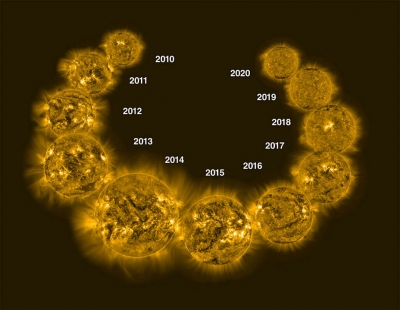
The solar cycle is an approximately 11-year cycle experienced by the Sun. During the solar cycle, the Sun’s stormy behavior builds to a maximum, and its magnetic field reverses. Then, the Sun settles back down to a minimum before another cycle begins. About every 11 years, the Sun’s magnetic field does a flip. In other words, the north pole becomes the south pole, and vice versa. Scientists use sunspots to track solar cycle progress. Much of the Sun’s tempestuous nature comes from its core. At its core is dense, electrically charged gas. Electrically charged gas is a special form of matter called a plasma. This roiling, boiling plasma generates the Sun’s powerful magnetic field. Like Earth’s magnetic field, the Sun’s magnetic field has a north pole and a south pole. On the Sun, however, the magnetic fields are much messier and more disorganized than on Earth. The beginning of a solar cycle a solar minimum, when the Sun has the least sunspots and when the magnetic field is at its weakest. Over time, solar activities such as solar flares or coronal mass ejections increase. These can spew light, energy, and solar material into space. Solar cycles are being tracked since 1755 and we are currently in the 25th phase. The previous solar cycle ran from 2008 to 2019. We are currently escalating towards solar maximum (due to take place around July 2025), when the solar magnetic field is at its strongest.
Sunspots are areas of particularly strong magnetic forces on the Sun’s surface. They appear darker than their surroundings because they are cooler. Even so, scientists have discovered that when there are lots of sunspots, the Sun is actually putting out MORE energy than when there are fewer sunspots. During solar maximum, there are the most sunspots, and during solar minimum, the fewest.
Credit : Sci Jinks
Picture Credit : Google




